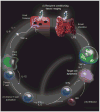Current and future approaches for control of graft-versus-host disease
- PMID: 20151032
- PMCID: PMC2819425
- DOI: 10.1586/17474086.1.1.111
Current and future approaches for control of graft-versus-host disease
Abstract
Graft-versus-host disease (GVHD), both acute and chronic, remains one of the major barriers to improving outcomes after allogeneic stem cell transplantation. The pathophysiology of GVHD is complex and incompletely understood. GVHD is believed to arise from the interaction of: tissue damage and proinflammatory cytokines causing activation of antigen-presenting cells (APCs, donor T-cell activation by APCs and cytokines and host tissue injury by effector T lymphocytes and proinflammatory cytokines. There is also a role for additional lymphocyte subtypes (naive and memory T cells, regulatory T cells, natural killer T cells and B cells) in GVHD pathogenesis. Strategies to improve donor-recipient HLA match, and to minimize conditioning toxicity, cytokine release and APC and effector T-lymphocyte activation, will likely improve prophylaxis of acute (and possibly chronic) GVHD. Therapy of established acute and chronic GVHD is still heavily dependent on corticosteroids, despite their limited efficacy and considerable toxicity. Novel agents (and/or combinations of agents) comprising pharmacologic, biologic and cellular therapies targeting specific steps or subsets involved in immune activation will likely comprise future advances in GVHD control. This article reviews the current state of knowledge regarding the prevention and treatment of acute and chronic GVHD. Novel approaches currently undergoing evaluation are also highlighted.
Keywords: allogeneic stem cell transplantation; graft-versus-host disease.
Conflict of interest statement
No writing assistance was utilized in the production of this manuscript.
Figures
Similar articles
-
Acute graft-vs-host disease: pathobiology and management.Exp Hematol. 2001 Mar;29(3):259-77. doi: 10.1016/s0301-472x(00)00677-9. Exp Hematol. 2001. PMID: 11274753 Review.
-
Recent Metabolic Advances for Preventing and Treating Acute and Chronic Graft Versus Host Disease.Front Immunol. 2021 Oct 12;12:757836. doi: 10.3389/fimmu.2021.757836. eCollection 2021. Front Immunol. 2021. PMID: 34712243 Free PMC article. Review.
-
Alloreactivity as therapeutic principle in the treatment of hematologic malignancies. Studies of clinical and immunologic aspects of allogeneic hematopoietic cell transplantation with nonmyeloablative conditioning.Dan Med Bull. 2007 May;54(2):112-39. Dan Med Bull. 2007. PMID: 17521527 Review.
-
Blockade of TIM-1 on the donor graft ameliorates graft-versus-host disease following hematopoietic cell transplantation.Blood Adv. 2019 Nov 12;3(21):3419-3431. doi: 10.1182/bloodadvances.2019000286. Blood Adv. 2019. PMID: 31714958 Free PMC article.
-
International Society for Cell & Gene Therapy Stem Cell Engineering Committee: Cellular therapies for the treatment of graft-versus-host-disease after hematopoietic stem cell transplant.Cytotherapy. 2023 Jun;25(6):578-589. doi: 10.1016/j.jcyt.2023.02.007. Epub 2023 Mar 21. Cytotherapy. 2023. PMID: 36941149 Review.
Cited by
-
The successful use of alemtuzumab for treatment of steroid-refractory acute graft-versus-host disease in pediatric patients.Pediatr Transplant. 2014 Feb;18(1):94-102. doi: 10.1111/petr.12183. Epub 2013 Oct 30. Pediatr Transplant. 2014. PMID: 24384050 Free PMC article.
-
Mesenchymal stromal cell infusion to treat steroid-refractory acute GvHD III/IV after hematopoietic stem cell transplantation.Bone Marrow Transplant. 2017 Jun;52(6):859-862. doi: 10.1038/bmt.2017.35. Epub 2017 Mar 13. Bone Marrow Transplant. 2017. PMID: 28287644 Clinical Trial.
-
Administration of anti-CD20 mAb is highly effective in preventing but ineffective in treating chronic graft-versus-host disease while preserving strong graft-versus-leukemia effects.Biol Blood Marrow Transplant. 2014 Aug;20(8):1089-103. doi: 10.1016/j.bbmt.2014.04.028. Epub 2014 May 4. Biol Blood Marrow Transplant. 2014. PMID: 24796279 Free PMC article.
-
The delicate balance of graft versus leukemia and graft versus host disease after allogeneic hematopoietic stem cell transplantation.Expert Rev Hematol. 2023 Jul-Dec;16(12):943-962. doi: 10.1080/17474086.2023.2273847. Epub 2023 Dec 18. Expert Rev Hematol. 2023. PMID: 37906445 Free PMC article. Review.
-
Extracorporeal photopheresis for graft-versus-host disease: the role of patient, transplant, and classification criteria and hematologic values on outcome-results from a large single-center study.Transfusion. 2015 Apr;55(4):736-47. doi: 10.1111/trf.12900. Epub 2014 Oct 29. Transfusion. 2015. PMID: 25355659 Free PMC article. Clinical Trial.
References
-
- Przepiorka D, Weisdorf D, Martin P, et al. Consensus conference on acute GVHD grading. Bone Marrow Transplant. 1994;15(6):825–828. - PubMed
-
- Rowlings P, Przepiorka D, Klein J, et al. IBMTR severity index for grading acute graft-versus-host disease: retrospective comparison with Glucksberg grade. Br J Haematol. 1997;97:855–864. - PubMed
-
- Shulman HM, Sullivan KM, Weiden PL, et al. Chronic graft-versus-host syndrome in man: a long-term clinicopathologic study of 20 Seattle patients. Am J Med. 1980;69:204–217. - PubMed
-
- Mielcarek M, Martin PJ, Leisenring W, et al. Graft-versus-host disease after nonmyeloablative versus conventional hematopoietic stem cell transplantation. Blood. 2003;102(2):756–762. - PubMed
-
- Filipovich AH, Weisdorf D, Pavletic S, et al. Biol Blood Marrow Transplant. 12. Vol. 11. 2005. National Institutes of Health consensus development project on criteria for clinical trials in chronic graft-versus-host disease: I. Diagnosis and Staging Working Group Report; pp. 945–956. - PubMed
-
• The NIH consensus conference on chronic graft-versus-host disease (GVHD) took a critical step in organizing, codifying and refining how we approach chronic GVHD. The concepts presented should faciliate the development of clinical trials in this important area.
Publication types
MeSH terms
Substances
Grants and funding
LinkOut - more resources
Full Text Sources
Other Literature Sources
Research Materials
Miscellaneous

